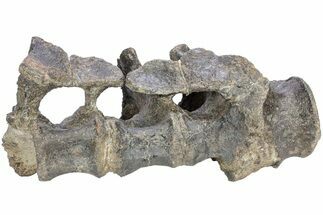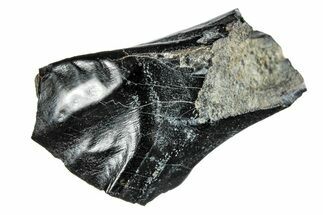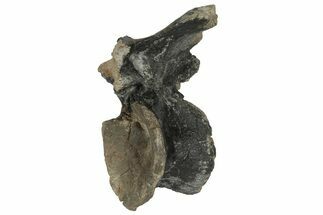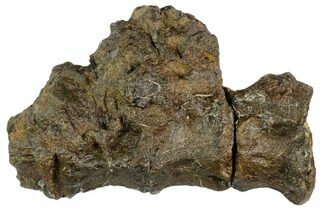4.8" Iguanodon Bone Section - Isle Of Wight
This is a 4.8" wide piece of Iguanodon bone, collected from the Lower Cretaceous-aged Wealden Clay Formation on the Isle of Wight. While complete or near complete bones are rare, water tumbled chunks are often found after they erode out of the cliffs on the isle. One edge of the bone has been cut flat
About Iguanodon
Iguanodon was a large, herbivorous dinosaur that lived during the Early Cretaceous period, approximately 125 million years ago. It belonged to the group of dinosaurs called ornithopods, known for their bird-like, bipedal stance. Iguanodon was among the first dinosaurs to be discovered and named, with fossils first identified in the early 19th century. It is recognizable for its robust, bulky body, long tail, and a distinctive thumb spike, which likely served as a defense mechanism against predators or as a tool for foraging.
Typically reaching lengths of about 30 feet and weighing up to 5 tons, Iguanodon had strong hind legs, allowing it to move both bipedally and quadrupedally, depending on the situation. Its broad, beaked mouth was well-suited for cropping vegetation, and its grinding teeth suggest it primarily ate tough plants. The discovery of Iguanodon provided crucial insights into the diversity and evolution of dinosaurs, marking it as a significant find in paleontology.
The name is derived from 'Iguana', a modern reptile, and 'don', meaning tooth. Scientists used to believe that two species of Iguanodon were found on the Isle of Wight, but one species has been moved off into another genus.
Iguanodon was a large, herbivorous dinosaur that lived during the Early Cretaceous period, approximately 125 million years ago. It belonged to the group of dinosaurs called ornithopods, known for their bird-like, bipedal stance. Iguanodon was among the first dinosaurs to be discovered and named, with fossils first identified in the early 19th century. It is recognizable for its robust, bulky body, long tail, and a distinctive thumb spike, which likely served as a defense mechanism against predators or as a tool for foraging.
Typically reaching lengths of about 30 feet and weighing up to 5 tons, Iguanodon had strong hind legs, allowing it to move both bipedally and quadrupedally, depending on the situation. Its broad, beaked mouth was well-suited for cropping vegetation, and its grinding teeth suggest it primarily ate tough plants. The discovery of Iguanodon provided crucial insights into the diversity and evolution of dinosaurs, marking it as a significant find in paleontology.
The name is derived from 'Iguana', a modern reptile, and 'don', meaning tooth. Scientists used to believe that two species of Iguanodon were found on the Isle of Wight, but one species has been moved off into another genus.
About Isle Of Wight Fossil Deposits
The Isle of Wight, located off the southern coast of England, is one of the world’s most renowned fossil sites, particularly for dinosaur discoveries from the Early Cretaceous period, roughly 125 million years ago. The island’s rich fossil deposits are found mainly along its southern and eastern coastlines, where eroding cliffs and beaches reveal layers of sedimentary rock full of prehistoric treasures. The geology consists of formations like the Wessex Formation, known for preserving dinosaur bones, footprints, and plant fossils, and the Vectis Formation, which includes both terrestrial and freshwater deposits, suggesting a mix of environments from ancient floodplains to lakes and swamps.
Some of the most notable finds on the Isle of Wight include fossils of large herbivorous dinosaurs such as Iguanodon, as well as predators like Neovenator and Baryonyx. These discoveries have contributed significantly to our understanding of Early Cretaceous ecosystems and dinosaur diversity in Europe. Fossils of fish, turtles, crocodiles, and pterosaurs have also been uncovered, alongside fossilized plants, creating a picture of a lush, semi-tropical landscape that once covered the area. Today, the Isle of Wight attracts paleontologists and enthusiasts alike, with its beaches providing a rich hunting ground for fossils that continue to emerge from the cliffs, especially after storms or heavy rains.
The Isle of Wight, located off the southern coast of England, is one of the world’s most renowned fossil sites, particularly for dinosaur discoveries from the Early Cretaceous period, roughly 125 million years ago. The island’s rich fossil deposits are found mainly along its southern and eastern coastlines, where eroding cliffs and beaches reveal layers of sedimentary rock full of prehistoric treasures. The geology consists of formations like the Wessex Formation, known for preserving dinosaur bones, footprints, and plant fossils, and the Vectis Formation, which includes both terrestrial and freshwater deposits, suggesting a mix of environments from ancient floodplains to lakes and swamps.
Some of the most notable finds on the Isle of Wight include fossils of large herbivorous dinosaurs such as Iguanodon, as well as predators like Neovenator and Baryonyx. These discoveries have contributed significantly to our understanding of Early Cretaceous ecosystems and dinosaur diversity in Europe. Fossils of fish, turtles, crocodiles, and pterosaurs have also been uncovered, alongside fossilized plants, creating a picture of a lush, semi-tropical landscape that once covered the area. Today, the Isle of Wight attracts paleontologists and enthusiasts alike, with its beaches providing a rich hunting ground for fossils that continue to emerge from the cliffs, especially after storms or heavy rains.
$135
SPECIES
Iguanodon sp.
LOCATION
Isle of Wight, UK
FORMATION
Wealden Clay
SIZE
4.8 x 3.3 x 1.6"
CATEGORY
SUB CATEGORY
ITEM
#284234
We guarantee the authenticity of all of our specimens.
 Reviews
Reviews












